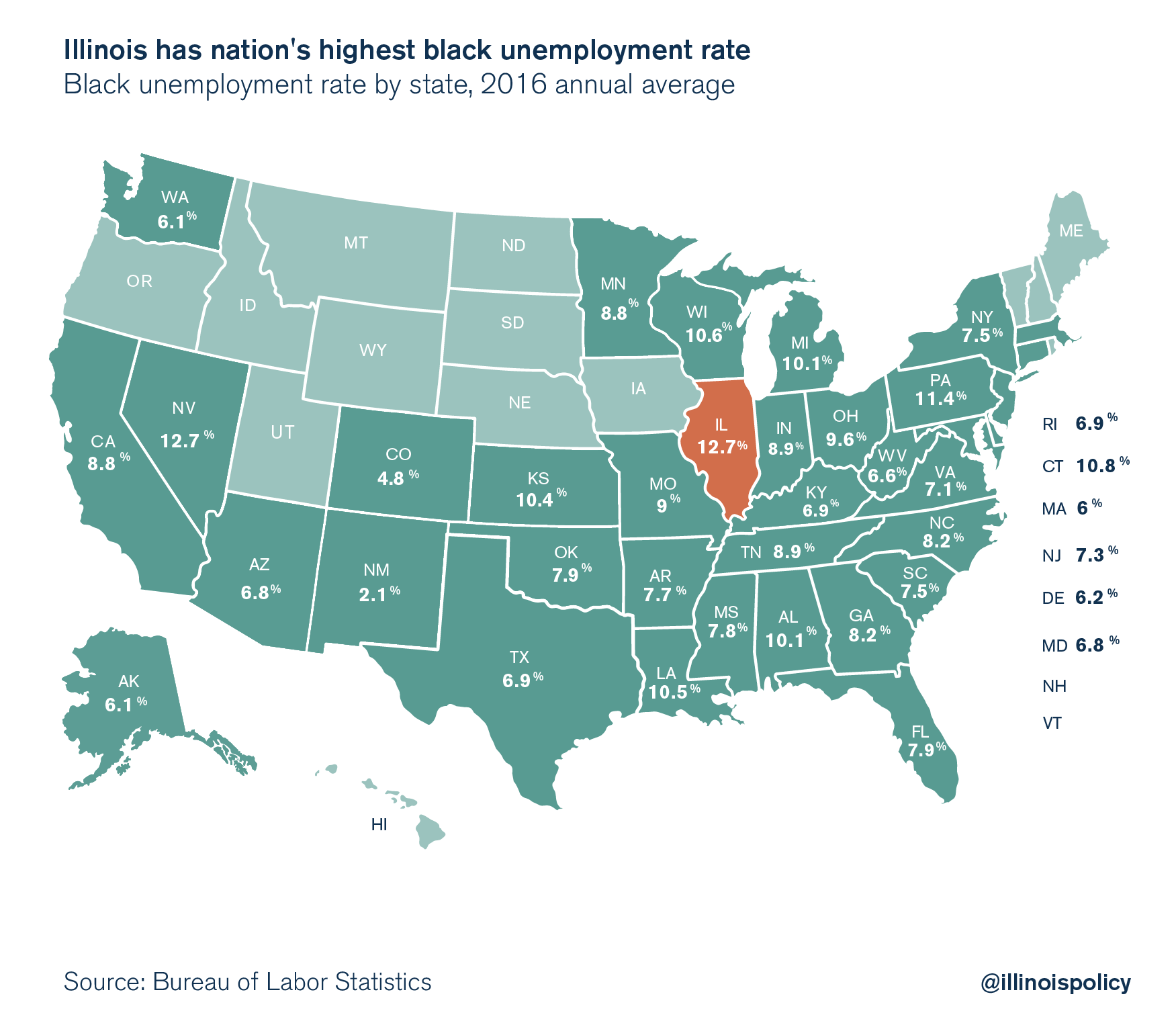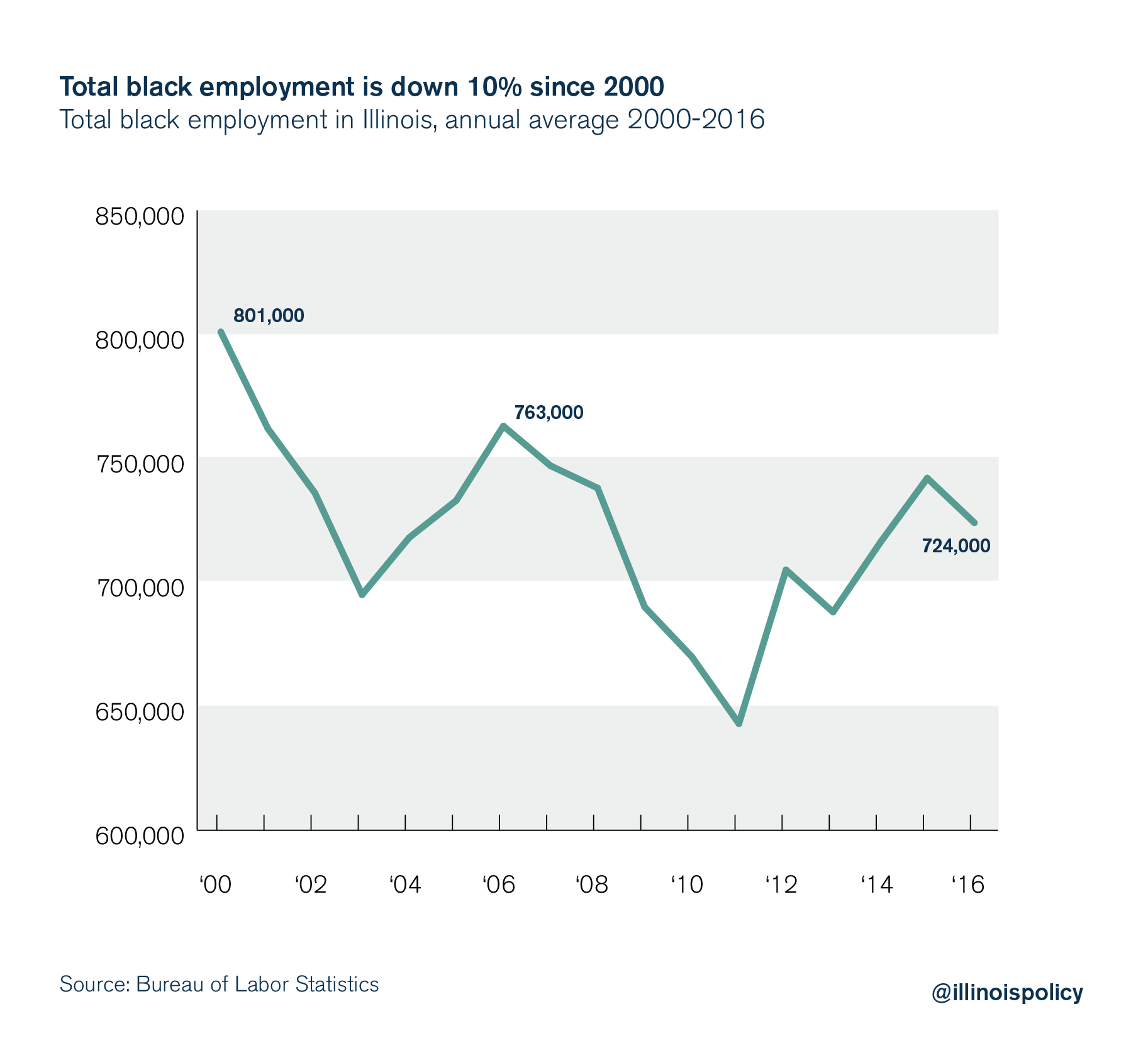Illinois had the nation’s highest black unemployment rate in 2016, according to annual unemployment data released by the federal Bureau of Labor Statistics, or BLS.1 Only 51 percent of black adults reported having some form of work in Illinois, highlighting an economic crisis that far too few political leaders are talking about. The BLS data support the conclusions in recent quarterly reports from the Economic Policy Institute, which have pointed to Illinois as having the nation’s highest black unemployment.2
Illinois’ weak job creation has a significant effect on the black community, especially due to manufacturing job losses in the Chicago area and a lack of construction job opportunities. Illinois’ black unemployment rate was 12.7 percent in 2016, compared with 6.7 percent for Latinos and 5 percent for whites.
Illinois’ 12.7 percent black jobless rate is the highest in the U.S., tied with Nevada. However, Illinois’ black population is seven times as large as Nevada’s, meaning Illinois’ crisis is playing out on a much larger scale. Illinois’ neighboring states achieved much lower black jobless rates than Illinois in 2016. (BLS does not calculate a black unemployment rate for Iowa, however, because the state’s black population does not constitute a sample large enough to be included in the BLS survey.)
The weighted average black jobless rate for all other states is 8.1 percent, and the weighted average among Illinois’ border states is 8.9 percent.

“Perhaps equally telling is Illinois’ black employment rate – the percentage of black adults who are engaged in some form of work. Illinois’ black employment rate is only 51.2 percent, compared with 63.2 percent for whites and 65 percent for Latinos. Illinois’ 51.2 percent black employment rate means that just over half of Illinois’ adult black residents have some form of work. Michigan is the only state with a lower black employment rate than Illinois.”
The weighted average black employment rate for other states is 56.8 percent, and the weighted average among Illinois’ border states is 59.2 percent.

Black men in Illinois had a 14.2 percent unemployment rate, the second-worst in the nation after Nevada’s 15.5 percent rate. Black women in Illinois had an 11.3 percent unemployment rate, also the second-worst in the nation, better only than Pennsylvania’s 12.6 percent rate.
Black employment in Illinois fell by 18,000 people from 2015 to 2016, and the number of black workers in Illinois’ labor force shrank by 16,000. Despite the shrinking workforce, the black unemployment rate increased to 12.7 percent from 12.2 percent year over year.
The number of black people working in Illinois has been in decline since the turn of the century. There were 77,000 fewer blacks working in Illinois in 2016 compared with 2000, a shocking 10 percent decline in total employment. By comparison, Illinois’ combined white and Latino employment is actually up by 272,000 since 2000, according to the BLS’ annual average data.3
Similarly, the recovery in black employment over the Great Recession era lags that of the rest of the state. Black employment is still down 5.1 percent compared with its pre-recession high.

Illinois’ black community deserves solutions
The Illinois General Assembly has largely ignored the fact that Illinois has the nation’s highest black unemployment rate. The problem should be discussed, studied and solved. And the ineffective solutions of the past aren’t going to fix it.
Black families deserve robust school choice so they can opt out of failing schools. And minimum wage hikes should be reconsidered – research finds overwhelming evidence that minimum wage hikes keep low-skilled and minority workers out of starter jobs.4 Minimum wage hikes will continue to create a barrier to entry to valuable first job opportunities so long as failing schools continue to do a poor job preparing young adults for the workforce.
Anti-growth industrial policies that hurt black families should also be reconsidered, especially the prevailing wage law and the taxes and regulations that drive away manufacturing jobs. These policy failures overwhelmingly affect black job opportunities. Research shows that prevailing wage laws result in lower wages for black construction workers and less construction work for black laborers.5 And Illinois’ manufacturing job losses, much the result of state and local policy failures, drive black families to seek industrial work in northwest Indiana and in Southern states.
Finally, commonsense reforms to Illinois’ criminal justice system and occupational licensing regulations will help reduce Illinois’ incarceration rate and eliminate hurdles that prevent black Illinoisans from landing a job after having been convicted of a crime. Nearly 60 percent of Illinois’ prison population is black, according to the Illinois Department of Corrections, and therefore black Illinoisans are more likely to face barriers to job opportunities that affect people with felony records.6
Addressing the nation’s highest black unemployment rate should be a top priority for Illinois lawmakers, who should tackle the problem with policy solutions that will have a positive impact on black families. Otherwise, black neighborhoods will continue to depopulate as families move east to Indiana and migrate to the South in search of better opportunities.
Endnotes
Endnotes
- Bureau of Labor Statistics, “Local Area Unemployment Statistics: Expanded State Employment Status Demographic Data.”
- Michael Lucci, “Illinois Ended 2016 with Highest Black Unemployment Rate of Any State,” Illinois Policy Institute, March 2, 2017.
- Bureau of Labor Statistics, “Expanded State Employment Status Demographic Data.”
- David Neumark, William Wascher, “Minimum Wages and Employment: A Review of Evidence from the New Minimum Wage Re- search,” (working paper, National Bureau of Economic Research, Cambridge, Mass., rev. ed. January 2007).
- Daniel P. Kessler and Lawrence Katz, “Prevailing Wage Laws and Construction Labor Markets,” (working paper, National Bureau of Economic Research, Cambridge, Mass., December 1999).
- Illinois Department of Corrections, Fiscal Year 2015 Annual Report.